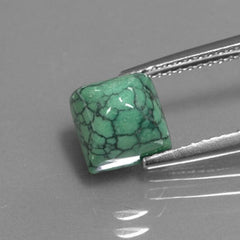Mexican Turquoise Jewelry
The Indians of pre-Columbian America are known for their religious artifacts, sculptures and turquoise jewelry.
It is believed that it was the Toltecs who developed and controlled the turquoise stone trade in the area that was later to become Mexico.
All Amerindian civilizations have either rubbed shoulders with each other, or succeeded one another, so that there have been enormous influences from one to the other of these civilizations.
Which, throughout Mesoamerica, lead to the manufacture of jewelery, works of art. craftsmanship using turquoise, a stone considered precious by the Aztecs, Mayans and Toltecs, who valued it more than gold.
Read this interesting article on cultural exchanges between Amerindian civilizations.

From left to right, funeral mask of Teotihuacan (INAH México), Aztec mask and decorated human Zapotec skull. The three pieces are encrusted with fragments of natural turquoises.
In Nahuatl, the common language of the Toltecs and Aztecs, "chalchíhuitl" means fine turquoise and "tuxíhuitl" common turquoise.
It seems that the Amerindians as well as the other civilizations (Persians, Egypt of the pharaohs and Chinese dynasties) having exploited the turquoises defined the quality of the turquoises according to criteria comparable to ours.
That is to say, the purity of the turquoise blue of the stone (the stones tending to the green being less valued) and the least possible veins characterize the stones most sought and therefore the most expensive.
 |
 |
Aztec ring from our collection
The history of turquoise in Mesoamerica
In Mexico, turquoise is at the crossroads between history, commerce, religion and the arts.
Indeed, if we found many religious artifacts encrusted with turquoise in the Aztec and Maya regions, the deposits of these stones are located in the north-west of the country.
Trade was needed to buy the turquoise stones.

The origin of the turquoises used by the Aztecs and Mayans is debated.
Early archaeological studies suggested that the stones used in southern Mexico came from mines in New Mexico, implying a vast commercial network crossing the region through the Sierra Madre.
This theory is ambitious, but not incoherent if one takes the trouble to remember that the Silk Road (5000 km) linked Asia to Turkey from 2000 years ago with our era.

A more recent theory suggests that Native Americans used the materials of their immediate environment directly.
Turquoises form naturally in deposits of copper ores and aluminum ores.
The Mexican states of Sonora and Baja California are the main producers of turquoise stones currently, but these gemstones are also found in the states of Jalisco, Zacatecas and Chihuahua, so much closer to the Aztec and Maya regions than New Mexico.

Mexico does not have turquoise mines as such. Mexican turquoises are secondary excavations of copper mines.
The Toltecs were the first Mesoamerican civilization to seek turquoise for religious use.
The stone was used to inlay funerary masks, religious artefacts or make symbolic jewels.
Since the different civilizations of the region have all shared important cultural characteristics, many have taken up this religious use of this stone, particularly the Aztecs and the Mayas.
No valid explanation has yet been given by archaeologists to explain their attraction to turquoise.
Modern use of turquoises in jewelery
If by its sacred and precious character, turquoise was reserved for men at the time of ancient civilizations, it is currently women who wear the most turquoise jewelry.
Just see the fashion magazines presenting the turquoise jewelery collections that are almost exclusively for women.
However turquoise is also one of the rare gemstones prized by men, but it is then used punctually for the manufacture of personalized handmade jewelry.
Turquoise being an opaque stone, it is almost always used in cabochon, mounted in closed setting or inlaid in the jewel, flush with the silver or the gold of it.
Price of a jewel with turquoise
Turquoise is a fine but affordable stone, its price has nothing to do with that of precious stones.
A stone usually costs a few tens of euros and can go up to a few hundred euros, in the case of a stone and exceptional quality.
Naturally, we are talking here about natural stones, because synthetic stones or imitations are more affordable.
Unlike diamonds and sapphires whose quality and value are assessed according to precise criteria (the famous 4C) weight, clarity, color and size, that of turquoise is based on the color, the vein matrix marking the stone and its scarcity.
The evaluation is then much more subjective, because if the natural shade of turquoise can vary from azure to deep green, the valuation of its color depends on the regions.
Similarly some people will tend to prefer turquoises with a strong die while others look for stones without any vein.

The photo below shows two turquoise stones from Afghanistan
Both stones cost the same price (about 100 euros) while the right one, turquoise green and heavily stamped weighs more than 36 carats, nearly double that of the left which is only 15.4 carats.
Turquoise work for Vivalatina jewelery
Mexican jewelers have inherited, among other things, Aztec and European cultures, both enhancing and using turquoise for jewelery.
This is why this stone is used for the manufacture of Mexican jewelry in silver, in the form of stone set, or fragments embedded in the jewel.
Logically, we ourselves have the opportunity to work turquoise, whether natural or synthetic, for the manufacture of our jewelry.
Turquoise is a friable stone that cuts well with diamond discs and is easy to polish.
It is brittle in nature which can sometimes complicate the stone cutting operation.

Cutting a turquoise stone
Here are some examples of our silver jewelery with turquoise stones:

Turquoise silver ring made in our mexican jewelry workdhop

Articulated bracelet in silver engraved with inlay of green turquoise fragments (fixed with resin).

Silver cross pendant with turquoise cabochon in the center, the stone is natural.

Bracelet with turquoises in solid silver. These turquoises are synthetic. Note that these are neither crimped closed, nor encrusted but fixed by a nail through them and a crimped end.

The different colors of natural turquoise
We usually have a uniform turquoise color on the jewels of the trade or on the pages of fashion magazines.
In fact, azure turquoises with no veins are rare, most come from elsewhere in Iran, which for centuries was the source of the most beautiful turquoises. Today the American Southwest turquoise mines compete in quality with Iranian stones.
You will understand that the stones of magazines and large chains of jewelry are synthetic or imitations.


Example of the different shades that can take the turquoise stone



American turquoise stones from the Cerillos mine. Note the variations in hue and the different types of matrices.
The more copper is contained in the stone, the more it pulls blue, while the iron and chrome accentuate its green color.
You can buy turquoise stones online at these addresses:
Sources :
Amerindian Archaeological Zone of Paquimé (in Spanish)
More information :
- Check out our custom made jewelry online service
- Turquoise stone bangle bracelet for men
- Aztec calendar medallion
and
- This article from the IGS (International Geology Society) will surely interest you:https://www.gemsociety.org/article/turquoise-jewelry-gem-information/
- Site of the American turquoise mine of Cerillos
- Custom design silver jewelry
- Find our more about Aztec symbols and meanings
- Value of lapis lazuli
- Natural sapphire stones




Comments
Virginia said:
I would like to send a picture of a pendant. I am unsure it’s real. At the back of pendant it has Mexico stamped but no silver markings. I did the scratch test on the maybe turquoise but I’m still unsure
Nicolas from Vivalatina said:
Hello Diana,
please contact us with a picture of your stone to get a better idea of your necklace.
https://vivalatina-shop.com/pages/jewelry-quotation
Regards
Diana Spatz said:
I have a stunning lime turquoise necklace set SS. Approximately 60+yrs old.
I would like to find more information on it.
Thank you in advance for your time.
Diana Spatz